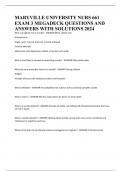MARYVILLE UNIVERSITY NURS 661
EXAM 3 MEGADECK QUESTIONS AND
ANSWERS WITH SOLUTIONS 2024
Who is at highest risk of suicide? - ANSWER White, elderly men
Schizophrenia
Single, never married, divorced, recently widowed
Previous attempts
Adolescents with depression, bullied, or family hx of suicide
Who is most likely to succeed at committing suicide? - ANSWER Older while males
What are some protective factors for suicide? - ANSWER Having children
Religion
Stronger alliances with medical providers and therapists
What is lethality? - ANSWER the probability that a person will successfully complete suicide
What is intent? - ANSWER Effective expectations for desire of active death
What is a suicide attempt? - ANSWER Includes all willful, self-inflicted life-threatening attempts that have
not led to death
What is suicidal ideation? - ANSWER thinking about suicide, usually with some serious emotional and
intellectual or cognitive overtones
Where in the brain do we theorize violence and aggression originate? - ANSWER Prefrontal cortex
,How to assess for homicidal ideation? - ANSWER Do you have homicidal ideation? Who do you want to
kill? How do you plan to do this? Do you have access to the means necessary? Do you intend to commit
the act?
What legal follow up is needed for homicidal ideation? - ANSWER Duty to warn
Based on state laws
Obsession - ANSWER 1. Recurrent and persistent thoughts, urges, or images that are experienced, at
some time during the disturbance, as intrusive and unwanted, and that in most individuals cause marked
anxiety or distress
2. The individual attempts to ignore or suppress such thoughts, urges, or images, or to neutralize them
with some other thought or action (i.e. by performing a compulsion)
Compulsion - ANSWER 1. Repetitive behaviors or mental acts that the individual feels driven to perform
in response to an obsession or according to rules that must be applied rigidly
2. The behaviors or mental acts are aimed at preventing or reducing anxiety or distress, or preventing
some dreaded event or situation, however, these behaviors or mental acts are not connected in a
realistic way with what they are designed to neutralize or prevent, or are clearly excessive
Obsessive-Compulsive Disorder (OCD) - ANSWER A. Presence of obsessions, compulsions, or both
B. The obsessions or compulsions are time-consuming (e.g. take more than one hour per day) or cause
clinically significant distress or impairment in social, occupational, or other important areas of
functioning
C. The obsessive-compulsive symptoms are not attributable to the physiological effects of a substance or
another medical condition
D. The disturbance is not better explained by the symptoms of another mental disorder
PANDAS - ANSWER Pediatric Autoimmune Neuropsychiatric Disorders Associated with Streptococcal
infections
OCD common co-morbid conditions - ANSWER MDD (Major depressive disorder)
Skin Picking
Hair Pulling
,Most Common Compulsions - ANSWER Checking
Ordering
Arranging
Washing/cleaning
Hand-washing
Flipping lights
Counting
Differentiation between OCD and eating disorders - ANSWER Those with eating disorders will be
counting calories, focused on weight loss or maintaining a specific weight
Treatment for OCD - ANSWER Cognitive Behavioral Therapy
Pharmacological Treatment for OCD - ANSWER First line treatment-SSRI (Luvox, fluoxetine)
Second-line treatment TCA with serotonergic properties (clomipramine)
SNRI or MAOI
Augmentation with benzos, lithium, or Buspar
DSM-5 Body Dysmorphic Disorder - ANSWER Preoccupation with perceived flaw on body taht is not
observed by others
Repetitive behaviors such as mirror checking, excessive grooming, skin picking, reassurance seeking,
clothes changing
Clinical significance
Differentiation from eating disorder
BDD common preoccupations - ANSWER Facial flaws
genitalia
, Differentiation between BDD and eating disorders - ANSWER BDD is more obsessed with one specific
body flow, not the entire body
Differentiation between BDD and OCD - ANSWER OCD may have food rituals but not obsession on a
specific body flaw
Treatment for BDD - ANSWER Cognitive Behavioral Therapy
Pharmacological treatment of BDD - ANSWER Clomipramine and fluoxetine reduce symptoms in about
50% of patients
DSM-5 Hoarding Disorder - ANSWER A. Persistent difficulty discarding or parting with possessions,
regardless of their actual value
B. This difficulty is due to a perceived need to save the items and to distress associated with discarding
them
C. The difficulty discarding possessions results in the accumulation of possessions that congest and
clutter active living areas and substantially compromises their intended use.
D. The hoarding causes clinically significant distress or impairment in social, occupational, or other
important areas of functioning
E. The behavior is not attributable to another medical condition
F. The hoarding is not better explained by the symptoms of another mental disorder
Hoarding Treatment - ANSWER Cognitive Behavioral Therapy
Hoarding Pharmacological Treatment - ANSWER SSRI (difficult to treat with medication)
Hoarding Safety Issues - ANSWER Falls
Fires
Stuff falling on them
Infections
Health hazards




